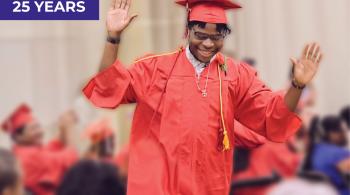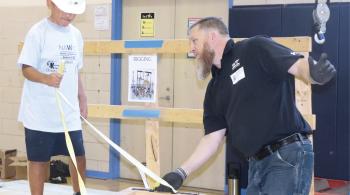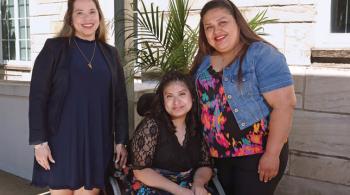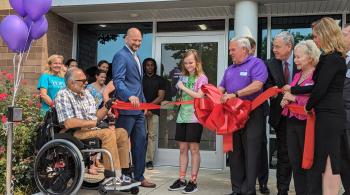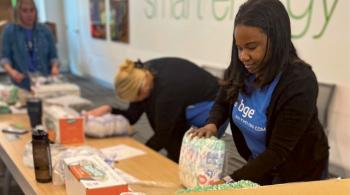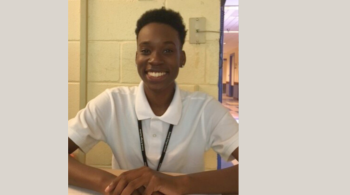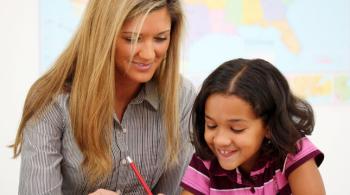By Laura Thornton
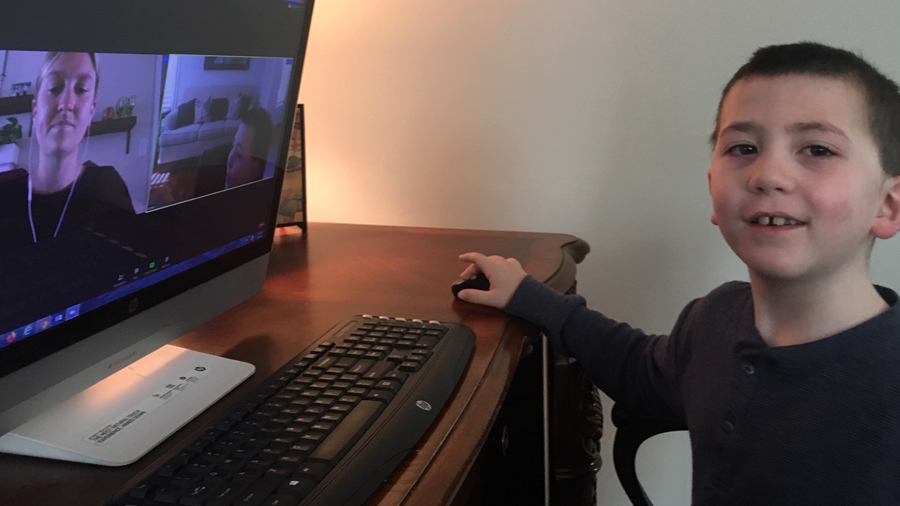
Stay-at-home orders due to the new coronavirus this past spring presented a particular challenge to Kennedy Krieger School Programs: How would teachers, teaching assistants, clinicians, behavioral specialists and other school-based service providers continue to serve students while school buildings remained closed? With each of Kennedy Krieger Institute’s approximately 500 students having their own individualized education program (IEP), there was no easy—let alone established—solution.
But in just two weeks, school staff members developed a continuity of learning plan for each student, working closely with each student’s parents or guardians and local school system to be sure that students’ learning, therapeutic, behavioral and other needs would be met. It was no small feat, with staff members designing innovative solutions to ensure the very best for their students.
“We made sure that we held an IEP meeting for every one of our students,” says Dr. Linda Myers, the Institute’s vice president of school programs. “In a normal year, we’d hold 500 IEP meetings in a rolling cycle, but this past March, they had to happen all at once.”
The Switch to Distance Learning
Kennedy Krieger has four special education schools. In Baltimore, the Institute’s Fairmount Campus serves students in prekindergarten through grade eight, Kennedy Krieger High School serves students from grade nine through age 21, and the Institute’s LEAP (Lifeskills and Education for Students with Autism and Other Pervasive Behavioral Challenges) Program serves 60 students from kindergarten through age 21. Just outside of Washington, D.C., Kennedy Krieger’s Montgomery County Campus serves students in elementary through high school, up to age 21.
Collectively, the schools serve approximately 500 students at any one time. Currently, the students hail from 14 local school systems across Maryland, Virginia and Washington, D.C. One of the challenges of developing a continuity of learning plan for each student was that “each of those local systems has its own expectations in terms of how their students are served,” explains Patrick T. Seay, assistant vice president of school operations, admission, compliance and transition for Kennedy Krieger School Programs.
We all wanted the same thing—that which is in the best interest of each student.”
– Patrick T. Seay, assistant vice president of school operations, admission, compliance and transition for Kennedy Krieger School Programs
Seay and his team collaborated with each of the local school systems to coordinate a master continuity of learning plan format that would work for all of Kennedy Krieger’s students. Seay and his team managed to find a happy medium—an approach to creating and documenting distance learning plans that was agreeable to all 14 school systems, and that could be tailored for each individual student.
“We all wanted the same thing—that which is in the best interest of each student,” Seay says.
Virtual Classrooms
As some of Kennedy Krieger’s teachers and teaching assistants were already using Google Classroom to supplement in-person teaching, Kennedy Krieger School Programs chose that virtual classroom platform for distance learning. More than 200 password-protected virtual classrooms were soon up and running, with younger children each enrolled in one virtual classroom, and high school students each enrolled in up to seven.
Instructional technology coordinator Shaun Husted and mobile device support specialist Alex Yeager worked with each teacher and teaching assistant to ensure a smooth transition. They also worked with student families, helping them learn how to use the new technologies. “We did a lot of troubleshooting, as families weren’t used to using all of this technology at once,” Yeager says. “And because staff members and families are all using different devices, we tested out how different platforms worked on those different devices,” Husted adds.
Husted and Yeager also surveyed families to determine what additional devices and technologies families would need. Quite a few devices have been loaned out so far—for example, 21% of students are using iPads loaned to them by Kennedy Krieger, Dr. Myers says.
Teachers and teaching assistants quickly developed a flexible method of delivering lessons to students: They posted assignments in their virtual classrooms for students to access and complete, and developed prerecorded lectures, often customized for each student. They also began holding live, interactive lessons. That combination has allowed for multiple ways of learning—important for students with varying learning needs. It’s also allowed students to access distance learning at times of the day that work best for them and their family members.
We’re engaging with the students and being productive through purposeful activities that are allowing students to progress.”
– Limor Rauer, director of occupational therapy services for Kennedy Krieger School Programs
LEAP program teachers and teaching assistants built additional flexibility into distance learning plans. Lessons are posted in virtual classrooms at the start of the week, and then “students and their families can hop on whenever they have time and the kiddo is best ready for it,” says LEAP Principal Amy Myers.
“We offer live instruction as well, but we need to be flexible because our students sometimes aren’t ready to participate at any given time,” she adds. “When they engage with us, they really enjoy seeing the familiar faces of their teachers and teaching assistants, and that has allowed us to work with them in this new capacity.
Therapies Delivered via Telehealth
“The two main pieces involved in Kennedy Krieger’s switch to tele-education were setting up the distance learning platform and layering in the telehealth,” which uses video technology to deliver healthcare, Dr. Myers explains.
Approximately 100 clinicians serve Kennedy Krieger’s students, who each receive, on average, two therapeutic services, such as speech and language therapy, art and music therapies, occupational therapy, and counseling. “In an average week, before the pandemic, we were delivering about 800 clinical service sessions to our students a week,” Dr. Myers says.
Kennedy Krieger’s school clinicians talked with each student’s parents or guardians about which therapeutic services they all felt would work for that student via telehealth, and if any additional services should be added.
“Our clinicians would say to parents, ‘Here are the goals I’m thinking about, but what do you need?’ If what the parents mentioned wasn’t on a student’s IEP, then part of the process of developing a continuity of learning plan for that student might be that they added a new goal relevant to the stay-at-home situation,” Dr. Myers says. “A lot of what we did was just that—individualizing plans for each of our students.”
Kennedy Krieger’s Information Services team set up each clinician with a secure account on Zoom, the videoconferencing platform used across Kennedy Krieger to deliver telehealth to patients at home. For many therapeutic services, clinicians have relied on parents and caregivers to provide the support needed for a telehealth session to be successful. For example, a clinician might ask a parent to position their child’s arm during occupational therapy, or help keep their child on task during a counseling session.
Working directly with parents and caregivers while providing therapeutic services has been a new experience for many of Kennedy Krieger’s school clinicians. “In the school environment, therapy doesn’t involve parents or caregivers,” explains Limor Rauer, Kennedy Krieger School Programs’ director of occupational therapy services.
But initial awkwardness soon gave way to strong relationships—an unexpected surprise, Rauer says.
“It’s great to have parents and caregivers working with me and their child because they can say, for example, ‘What did we do outside today?’ and I can make up a song for the student and family to sing about that outdoor activity,” says Kennedy Krieger High School music therapist Alicia Barksdale. Singing songs and doing other musical activities helps alleviate anxiety and encourage self-expression, she explains.
Since distance learning began, Barksdale has used singing more than usual in music therapy sessions, as students don’t all have access at home to the different musical instruments available at school. “We sing songs I’ve made up about hand-washing and staying home and being safe, and the parents love those. It’s great to feel like we’re a team working together to help their child move forward.”
“It’s been very heartwarming,” Rauer adds, “to have extended family there, during clinical sessions. Siblings get involved; everyone is rooting their family member on. There’s a sense of camaraderie and pride in what is happening,” she says. “We wouldn’t normally be a part of that. This dynamic with our students’ families has been really positive, and a wonderful part of all of this.”
Working with students in their homes has led to additional surprises. “We’ve seen kids in their home environment display skills that we didn’t know they had,” Rauer says. And because some students often don’t demonstrate the level of independence at home that they do at school, many parents and caregivers are now seeing their children demonstrate skills that they’d never seen them do before.
Over the past several months, clinicians have continued to evaluate students’ progress toward meeting their IEP goals, adjusting services to meet each student’s need. “By the end of June, a vast majority of students had been ramped up to their previous level of services—what had been delivered in the building,” Rauer says.
Rauer and her team have been pleasantly surprised at how many students have benefited from telehealth. “It’s not like we’re just Zooming in and hanging out for half an hour. We’re engaging with the students and being productive through purposeful activities that are allowing students to progress.”
Incredible Collaboration
Since the switch to distance learning and telehealth, teachers, teaching assistants, clinicians and other school-based service providers have been working together in ways that weren’t previously easy to facilitate.
“Clinicians have been able to use Google Classroom to familiarize themselves with what teachers are teaching, so they can collaborate behind scenes,” Rauer says.
For example, an occupational therapist may recommend certain modifications be made to a student’s lesson plan, to help that student address therapy goals while completing the lesson. The therapist could also pick out certain elements of the lesson that they’ll work on with the student at their next occupational therapy session. This collaboration helps ensure that therapy and schoolwork complement—rather than duplicate—each other.
A similar collaboration between teachers and behavioral specialists has developed. Kennedy Krieger School Programs’ team of behavioral specialists is on call to “step” into a virtual classroom to help students when needed, just as they would in the physical classroom.
Whereas in the school building, behavioral specialists might take a student who needs a break from the classroom out to the hall for a walk, now they’ll use a breakout room on Zoom to help the student calm down before rejoining their class, explains Dr. Bob Harrell, Kennedy Krieger School Programs’ director of behavioral services. Dr. Harrell hopes that their presence in the virtual classrooms will translate to a more proactive presence in physical classrooms, when in-person classes resume. “It’s been an ongoing goal to try to get our staff into the classrooms more and be a proactive part of teaching.”
Dr. Harrell and his team have also developed drop-in “rooms” on Zoom. “Kids can come in and talk about sports or whatever they’re interested in,” Dr. Harrell explains. It’s part of the schools’ positive behavioral interventions and supports (PBIS) offered to students. “Part of good PBIS is that we’re not putting fires out; we’re proactively supporting students’ education,” Dr. Harrell explains.
We’ve been working more closely together as a team and becoming more flexible and more creative in terms of what’s best for students.”
– Amy Myers, principal of LEAP
Kennedy Krieger’s collaborative spirit is part of why distance learning and telehealth have been so successful. “One thing that makes us unique is our interdisciplinary collaboration and planning, which allowed us to mobilize quickly and provide individualized distance learning for students,” Dr. Myers says.
“We’re not the only ones doing distance learning, but we stuck to our strengths from before the pandemic and applied them to this new environment, and it’s working,” she adds.
To ensure that all students and families are receiving the support they need, school staff members continue to work with student families experiencing disparities in access to technology and in parents’ and caregivers’ abilities to monitor their children’s distance learning and schoolwork, due to work schedules or other constraints.
Kennedy Krieger school staff members’ collaborative spirit has only increased in recent months. “We’ve been working more closely together as a team and becoming more flexible and more creative in terms of what’s best for students,” says LEAP principal Amy Myers. That will serve Kennedy Krieger’s students well—not only in the present time of distant learning, but throughout their education at Kennedy Krieger.
Note: Kennedy Krieger is constantly evaluating the current health situation, and adjusting its guidelines for keeping students, patients, families, visitors and staff members safe. As of the publication of this story, Kennedy Krieger School Programs plans to continue to provide distance learning and therapies to students in the fall.



